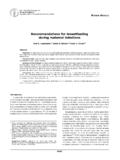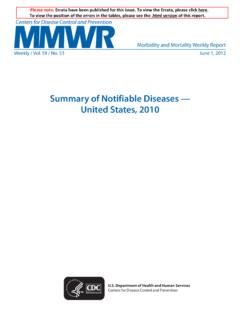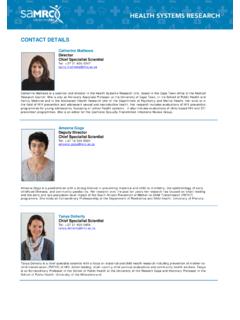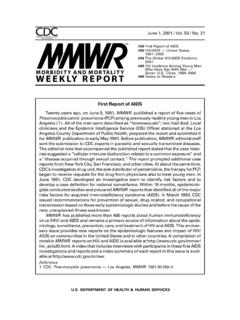Transcription of Foundations of Epidemiology - Jones & Bartlett Learning
1 CHAPTER1 Foundations of EpidemiologyOBJECTIVESA fter completing this chapter, you will be able to: Define Epidemiology . Define descriptive Epidemiology . Define analytic Epidemiology . Identify some activities performed in Epidemiology . Explain the role of Epidemiology in public health practice andindividual decision making. Define epidemic, endemic, and pandemic. Describe common source, propagated, and mixed epidemics. Describe why a standard case definition and adequate levels ofreporting are important in epidemiologic investigations.
2 Describe the Epidemiology triangle for infectious disease. Describe the advanced Epidemiology triangle for chronicdiseases and behavioral disorders. Define the three levels of prevention used in public health and Epidemiology . Understand the basic vocabulary used in 6/19/09 11:16 AM Page 1 Jones and Bartlett Publishers, LLC. NOT FOR SALE OR DISTRIBUTIONIn recent years, the important role of Epidemiology has become increasingly is a core subject required in public health and health education programs;it is a study that provides information about public health problems and the causes ofthose problems.
3 This information is then used to improve the health and social conditionsof people. Epidemiology has a population focus in that epidemiologic investigations areconcerned with the collective health of the people in a community or population understudy. In contrast, a clinician is concerned for the health of an individual. The clinicianfocuses on treating and caring for the patient, whereas the epidemiologist focuses on iden-tifying the source or exposure of disease, disability or death, the number of personsexposed, and the potential for further spread.
4 The clinician treats the patient based on sci-entific knowledge, experience, and clinical judgment, whereas the epidemiologist usesdescriptive and analytical epidemiologic methods to provide information that will ulti-mately help determine the appropriate public health action to control and prevent thehealth defined as the study of the distribution and determinants of health-related states or events in human populations and the application of this study to the pre-vention and control of health word Epidemiology is based on the Greekwords epi, a prefix meaning on, upon.
5 Or befall ; demos, a root meaning the people ; andlogos, a suffix meaning the study of. In accordance with medical terminology, the suffixis read first and then the prefix and the root. Thus, the word Epidemiology taken literallyrefers to the study of that which befalls people. As such, Epidemiology is commonly referredto as the basic science or foundation of public involves sound methods of scientific investigation. Epidemiologicinvestigations involve descriptive and analytic methods which draw on statistical tech-niques for describing data and evaluating hypotheses, biological principles, and causal the-ory.
6 Both descriptive and analytic Epidemiology are discussed at length in later , descriptive Epidemiology involves characterization of the distribution of health-related states or events. Analytic Epidemiology involves finding and quantifying associa-tions, testing hypotheses, and identifying causes of health-related states or the distribution of disease means to identify the frequency and pattern ofhealth-related states or events among people in the population. Frequency refers to thenumber of health-related states or events and their relationship with the size of the at-riskpopulation.
7 Typically, the number of cases or deaths is more meaningful when consideredin reference to the size of the corresponding population, especially when comparing risksof disease among groups. For example, despite differences in population sizes across timeor among regions, meaningful comparisons can be made of the burden of HIV/AIDS byusing proportions or percentages. In 2007, the estimated percentage of adults 15 to 49 yearsof age with HIV/AIDS was in sub-Saharan Africa, in the Middle East and NorthAfrica, in South and Southeast Asia, in East Asia, in Oceania, in LatinAmerica, in the Caribbean, in Eastern Europe and Central Asia, in West-ern and Central Europe, and in North refers to describing health-related states or events by who is experiencing thehealth-related state or event (person)
8 , where the occurrence of the state or event is highestor lowest (place), and when the state or event occurs most or least (time). In other words,epidemiologists are interested in identifying the people involved and why these people areaffected and not others, where the people are affected and why in this place and not others,and when the state or event occurred and why at this time and not example, in 1981 the Centers for Disease Control and Prevention (CDC) reportedthat five young men went to three different hospitals in Los Angeles, California with con-firmed Pneumocystis cariniipneumonia.
9 These men were all identified as 1 Foundations of 6/19/09 11:16 AM Page 2 Jones and Bartlett Publishers, LLC. NOT FOR SALE OR DISTRIBUTIONOn July 27, 1982, this illness was called AIDS, and in 1983, the Institut Pasteur in Francefound the human immunodeficiency virus , which causes the determinants or determining factors of health-related states or events isa primary function of Epidemiology . A cause is a specific event, condition, or characteristicthat precedes the health outcome and is necessary for its occurrence.
10 An adverse health out-come can be prevented by eliminating the exposure. If an environmental exposure isrequired for the health outcome to occur, the causative factor is necessary. If the health-related state or event always occurs because of the exposure, the causative factor is suffi-cient. For example, a mother s exposure to rubella virus (Rubivirus) is necessary for rubellato occur; however, exposure to rubella virus is not sufficient to cause rubella because noteveryone infected develops the causal associations is complex and typically requires making a judgment based on the totality of evidence, such as a valid statistical association, time sequence ofevents, biologic credibility, and consistency among studies.















